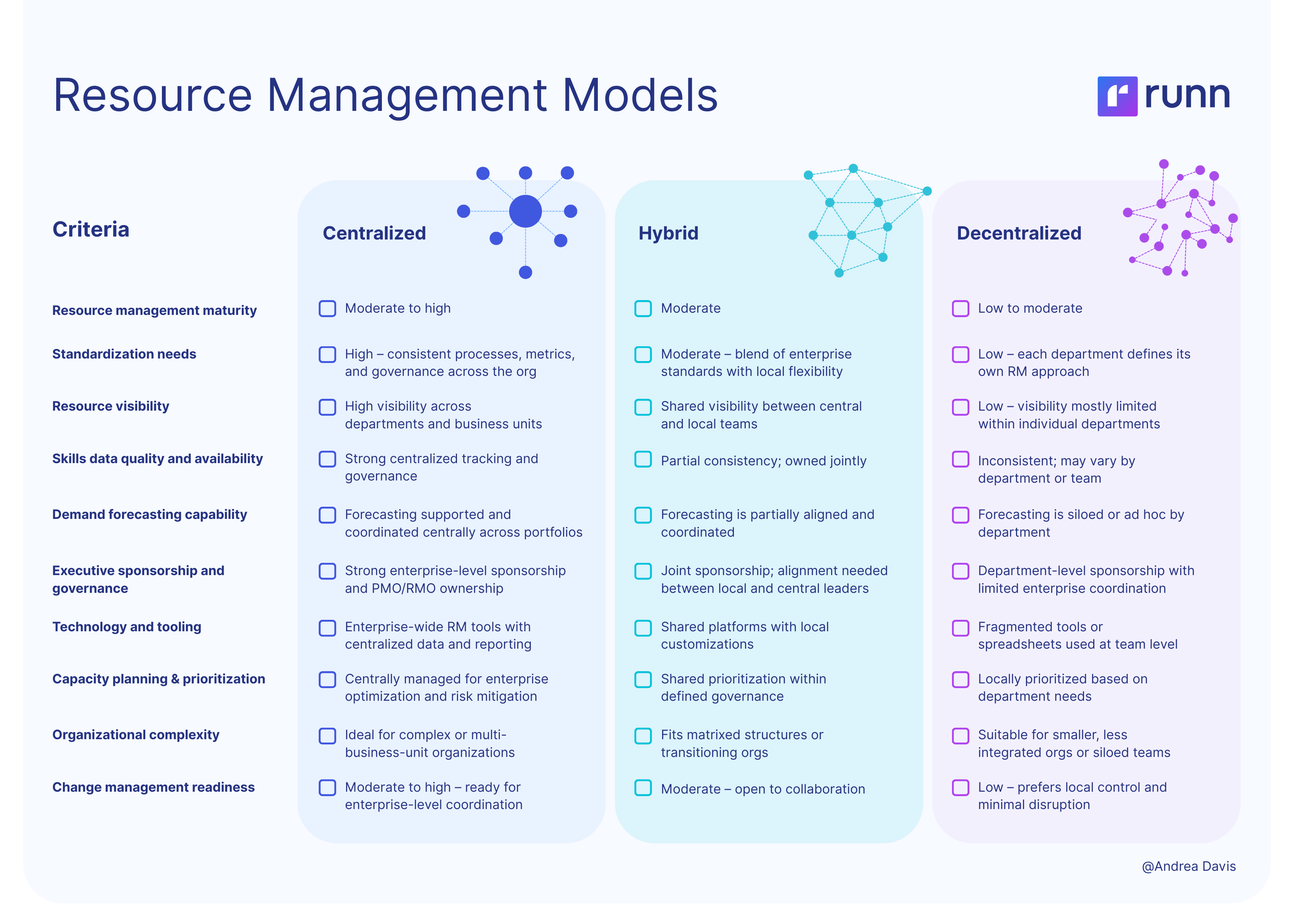Centralized, decentralized...or something halfway between the two? Discover which resource management model is the best fit for your business.
.avif)
Having a defined system in place to manage resources is crucial for not only effective management but also boosting organizational productivity and performance.
But before you can make the most of these benefits, you need to find and implement a resource management model that can best help your organization handle resources efficiently.
And this concise guide aims to help you do just that.
We’ll look at the three leading resource management models, their pros and cons, and wrap up with questions to ask yourself to identify which model suits your organization best.
A resource management model refers to the way an organization structures, organizes, and manages its resources including human and software resources.
You need a resource model to optimally manage resources to:
At the end of the day, an efficient resource management model — tailored to meet your business’s needs — helps you increase cost savings and unlock revenue growth as you enjoy a competitive edge.
Since these models are aimed at effectively managing human resources, they take an employee-led approach which, in turn, increases employee retention and reduces burnout among your workforce.
Having said that, let’s look at the three broad resource management models that you can leverage:

As the name suggests, centralized resource management involves a central authority making all resource-related decisions including resource planning, allocation, and budgeting.
This central authority could be a dedicated team or department — really anyone from a Resource Management Office (RMO) in a large organization to a senior resource manager at a small business.
Keep in mind though: centralizing resources isn’t limited to funneling all resource-related authority and decision-making to one person. There is a lot of process building that has to happen to support centralization efforts.
For example, one foundational pillar of centralized resource management involves establishing robust data management practices and consolidating resource data into one platform. In turn, this serves as a:
Further reading ➡️ Centralized Resource Management: The What, Why, & How.
High-performing organizations that understand the power of a skilled talent pool leverage centralized resource management. Their aim? To have a streamlined system in place that helps them achieve resource management maturity, guaranteeing timely project deliveries within defined budgets, and a motivated workforce that is neither overstretched or under-challenged.
A central system for managing resources improves project outcomes, resource utilization, and employee satisfaction. Here’s a full rundown of the benefits of a centralized resource model:
While the perks of a centralized resource model far outweigh its downsides, this doesn’t mean it is free of any cons. In fact, the leading two shortcomings are:
The exact opposite of a central model, decentralized resource management involves individual teams managing resources and making relevant decisions.
Since teams manage their individual resources in this setting, it’s often referred to as decentralized resource management.
Thanks to this distributed responsibility, there’s a greater sense of democratic, collaborative decision making.
However, there’s no defined, streamlined system in place as all teams have their unique ways of managing resources. Naturally, this can lead to under-utilization, inadequate capacity planning, and unpredictable employee engagement levels — culminating in poor outcomes such as high turnover and frequently missed deadlines.
The benefits of this management model entirely depend on how effectively and efficiently teams manage their people. There’s typically a loose blueprint guiding decentralized resource management with teams mostly having different systems and processes in place.
Mainly, distributed or decentralized resource management benefits you in the following ways:
Since nothing is centralized — in other words, there’s no single source of truth — the model delivers the following downsides:
Note that according to RMI, organizations are nearly 40% more likely to have lower utilization/throughput when RM is managed in a decentralized model.
A hybrid model takes from both centralized and decentralized resource management models where some strategic decisions are handled centrally with departments managing the day-to-day decision-making.
For instance, conflict resolution may be centrally managed, but skills audit and project allocation may be handled by individual departments.
Since a hybrid model marries both centralized and decentralized approaches to resource management, it brings together the strengths of both worlds. These strengths culminate in the following benefits:
Despite it canceling out the downs of both centralized and decentralized management, the hybrid model shows these shortcomings:
That said, planning and executing a hybrid resource management model takes extensive work upfront. In fact, finding the right balance between centrally managed and departmentally handled decisions can not only be challenging but also time-consuming.
The best answer for this lies within you. A few questions to ask yourself to get to this answer:
We teamed up with Andrea Davis, RMCP to create a powerful visual sheet that breaks down every model across 10 critical criteria - from standardization and visibility to forecasting and change readiness. Use it to:
🔍 Understand the strengths and trade-offs of each approach
📊 Assess your organization's current state
🚀 Make informed decisions about where you want to go

Whatever resource management model you decide to leverage, our word of advice is to centralize resources in a single platform.
This means that whether your decisions are centrally or departmentally managed — or split between the two — all data is captured in a single resource management platform. This way, you’ll have:
With all this said, it’s essential you first spend time understanding what you need to make informed decisions. We’ll leave you with some of our most popular resource management guides to give you a helping hand!
➡️ Resource Optimization Explained for Beginners
➡️ Experts Share 11 Reasons Why Resource Management is Important
➡️ Transitioning From Spreadsheets to Runn for Resource Management (Interview)